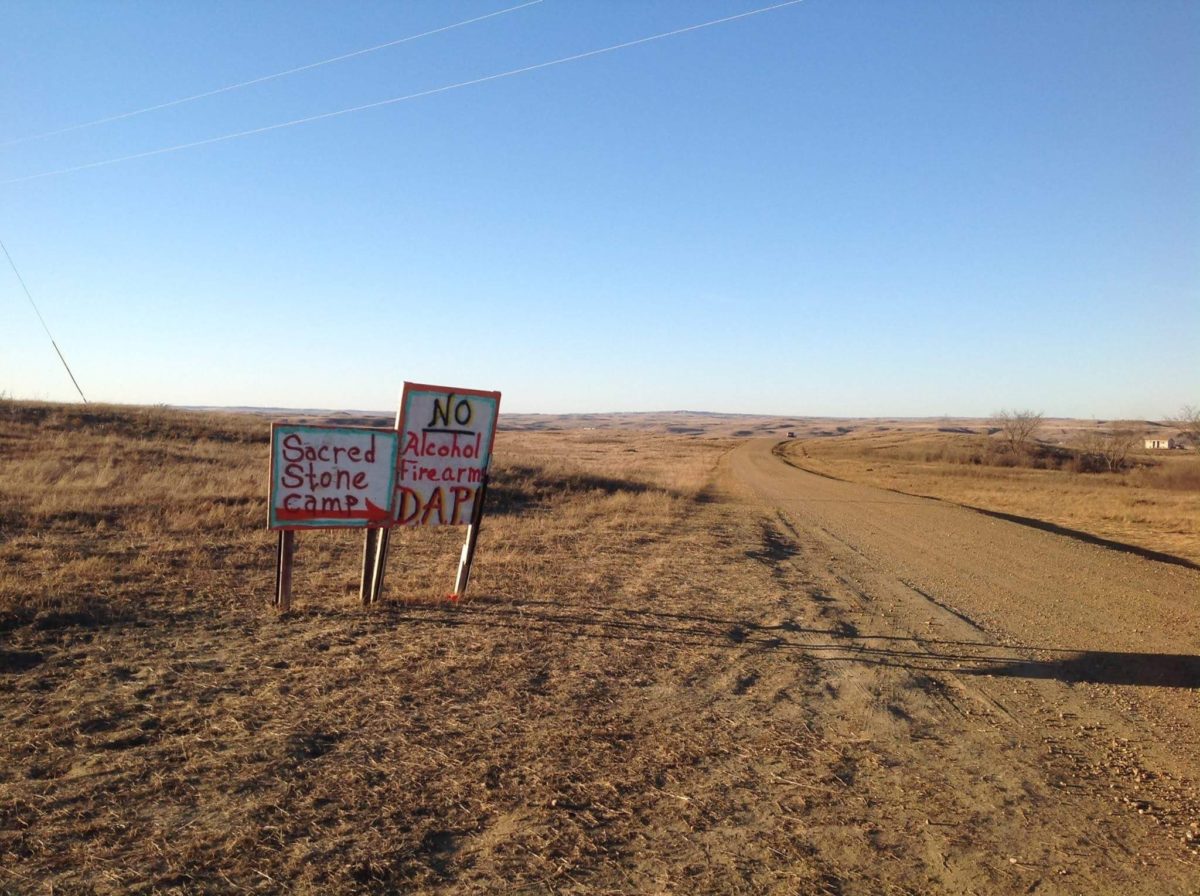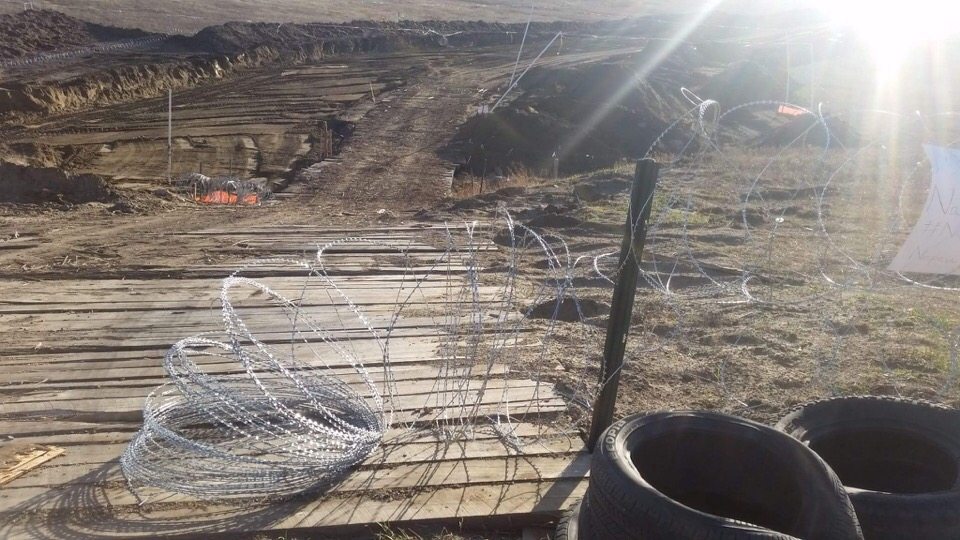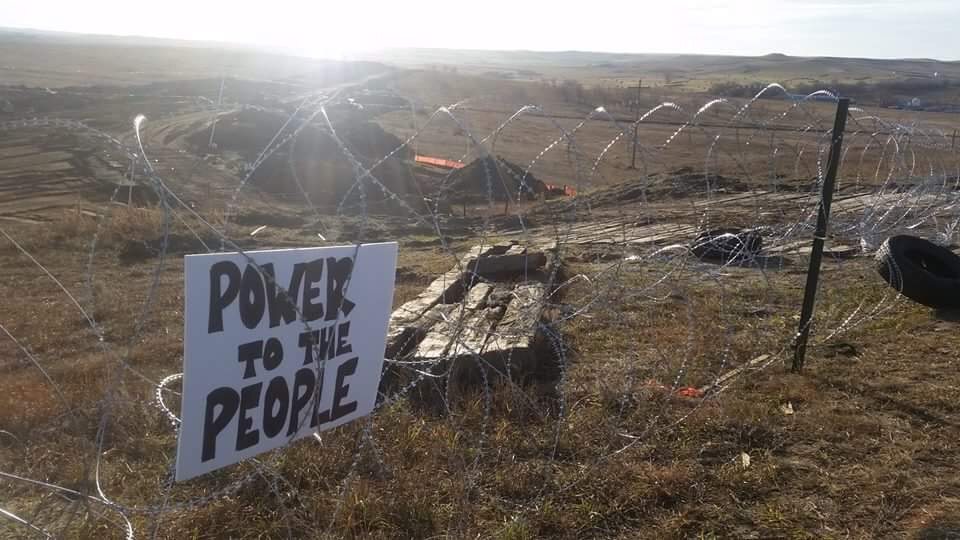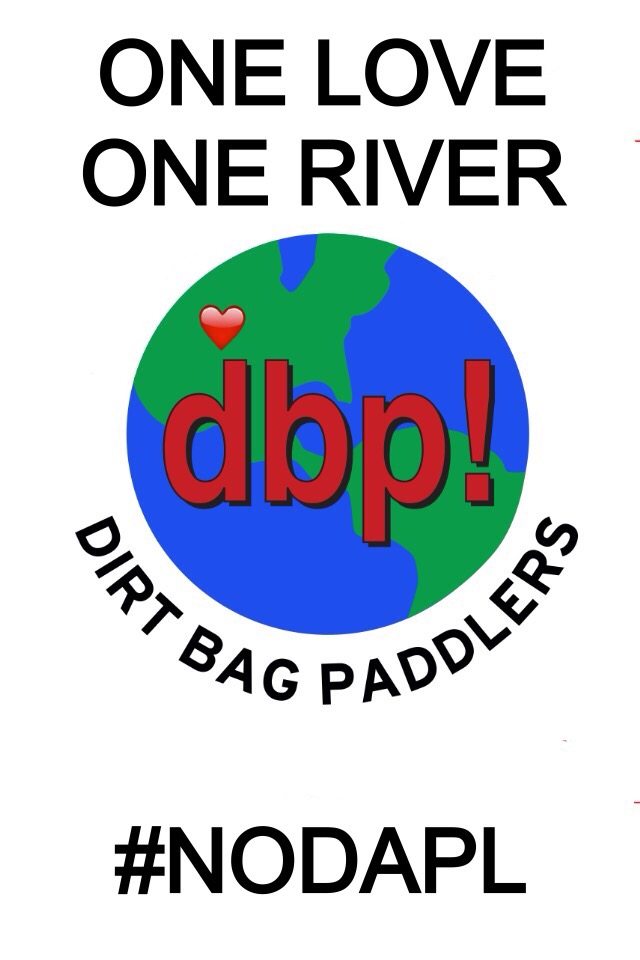Article by Michael Potter, Ythsta Prather Resovich, and Mike Toughill; photos by Michelle Terrell, Kurt Stegen, Jesse Rider, and Valerie Gordon.
Photo – MTerrell
We the People: the first words of our constitutional preamble; words of power, words of hope and words that guarantee that our voice will be heard. Over 150 peaceful protests are scheduled to occur today (11-15-16) across America in the first nationwide demonstrations against DAPL. We the people.
The Dakota Access Pipeline Project is a new, approximately 1,172-mile, 30-inch diameter pipeline carrying 470,000 barrels of crude oil per day, which will connect the rapidly expanding Bakken and Three Forks production areas in North Dakota to Patoka, Illinois. Seems simple enough right? Anything but… We The People are being threatened with the potential contamination of the most important and most necessary resource we have on earth, water.
This pipeline project has been rushed through engineering, pushed through the permitting process and no true and complete environmental impact studies have been done. Finally agreed to, albeit reluctantly, by the Army Corp of Engineers in July of 2016, it looked like this was a done deal. The now defunct XL pipeline went through 7 years of studies and meetings before finally being quashed. The DAPL? A mere 10 months start to finish, and it’s only 7 miles shorter than its now defunct cousin. The potential damage to drinking water, delicate riparian habitat, wildlife and human life alike is unprecedented. A rupture anywhere on this pipeline’s route and the rivers and watersheds it crosses would make the Valdez look like an oil stain left by an old Volkswagen. The Pipeline’s route takes it through active farmland, forests, and across the heartland’s major rivers: The Big Sioux, the Missouri, and the Mississippi, some with multiple crossings. The truth of this is simple: In light of the recent pipeline leaks in Alabama and into the Susquehanna River, we have reached the point where it’s not a matter of IF something will go wrong but WHEN something will go wrong. http://www.ecowatch.com/pipeline-spills-2061960029.html Yet construction continues.
Then there is the complete disregard for the Civil Rights of We The People whose land this crosses. The IUB, a three-person committee appointed by Gov. Terry Branstad, granted Energy Transfer Partners the right of eminent domain, putting 475 parcels of private lands into the hands of a for profit corporation using a law designed to allow governmental infrastructure such as roads and railways to occur… There was even one farmer who was allegedly offered a teenage prostitute to give up his land. http://www.inforum.com/news/3745285-man-alleges-company-offered-prostitute-pipeline-right-way He lost anyway, and his property was seized. To say the least there are almost as many pending lawsuits associated with this as there are feet of pipe to be laid down. Still construction continues.
Still doesn’t really concern you right? Wrong. History has a strange habit of repeating itself, and in this case the parallels are saddening. At the heart of the matter is a story of a people that have been taken advantage of, a people robbed and lied to, marginalized and never defended before. Adding insult to injury, the route of the pipeline will destroy sacred, priceless relics and even the cemeteries and burial grounds of the Lakota Nation, a people who have been repeatedly abused by the US Government. DAPL is under construction and already on reservation lands which belong to the people who are the true owners of the land we call the United States. The ones who actually have the right to say “We The People.”
Photo- KStegen
“There was a time when the land was sacred, and the ancient ones were as one with it. A time when only the children of the Great Spirit were here to light their fires in these places with no boundaries…
In that time, when there were only simple ways, I saw with my heart the conflicts to come, and whether it was to be for good or bad, what was certain was that there would be change.”
– The Great Spirit Wakan Tanka
The Lakota People are the largest of three branches of an extended family, the proud nation of Native Americans commonly referred to as the Sioux. They refer to themselves as the Lakota, which means “friends” or “allies”. Also referring to themselves as the Tetons, meaning “prairie dwellers,” the nation is a union of seven related tribes, referred to as the Seven Council Fires: Ogalala (“they scatter their own,” or “dust scatterers”), Sicangu or Brule (“Burnt Thighs”), Hunkpapa (“end of the circle”), Miniconjou (“planters beside the stream”), Sihasapa or Blackfoot (not to be confused with the Blackfoot Tribe, a separate unrelated group), Itazipacola (or Sans Arcs: “without bows”), and the Oohenupa (“Two Boilings” or “Two Kettle”). They make their homes on five reservations in North and South Dakota: Rosebud, Pine Ridge, Lower Brule, Cheyenne, and Standing Rock. Standing Rock is infamous as the place where legendary medicine man Chief Sitting Bull and his son were gunned down by Agency police for resisting arrest in 1890. Today it is the site of the resistance of the people against the DAPL oil pipeline, another struggle against armed authority.
Photo- K Stegen
There have been many clashes with outsiders since the first contact with white men 200 years ago. Lewis and Clark first met them on their “discovery” journey up the Missouri River, in the land of millions of bison, trading and eventually fleeing from this most powerful warlike tribe of the region. For many years after, the only contact with whites was the occasional fur trader. Then, pioneers sought a path west after the discovery of gold in California. This route ran through the lands of the Lakota. Seeking to insure safe passage on the Oregon Trail, the United States treaty commissioners met with the Indian Nations leaders in 1851 at Fort Laramie Wyoming (a fort built on Indian land in direct violation of an earlier treaty). Representatives of the Lakota, led by Chief Red Cloud, along with their neighbors the Cheyenne, Arapaho, Crow, Assiniboine, Mandan, Hidatsa, and Arikara, were present for the agreement, recognizing that all of the land covered within the treaty belonged to the Indian Nations, and the United States claimed no part or ownership of said land.
The United States did not enforce the regulations set forth by the treaty, which would be repeated again and again. Soon settlers were homesteading illegally on the land, setting off a series of battles, Red Cloud’s War, that pushed the Lakota from Minnesota into Nebraska and South Dakota. Yet another agreement was signed, the Treaty of 1868, which guaranteed sole ownership of the Black Hills to the Lakota, and no whites were permitted into the territories. The people settled onto their current reservations, and instructed to give up their traditional way of life, following and hunting bison. This signaled the end of Red Cloud’s War.
Four years of peace passed, but it was not a good peace. The meat sent to feed the people was rotten, the flour was spoiled. Then George Custer’s US Cavalry detachment discovered gold in Black Hills territory. Prospectors flocked into the Indian lands by droves, forcing the tribe to protect their land in yet another war. Desperate, the people fled the agencies and resumed their nomadic way of life, running from the Army and driving off the illegal trespassers. Custer and his entire immediate command were killed on the banks of the Little Big Horn in 1876, but even this victory was not enough to save the Lakota way of life.
In 1877 the majority of the Lakota gave up their struggle and were confined onto reservations. Some fled north into Canada with Sitting Bull, but eventually succumbed to the pressure of starvation and homesickness, and returned to join their kin. The once proud people were once more prevented from hunting bison, which were hunted by hired white men to the brink of extinction, from those former millions of head to only a few thousand. A few years later the Great Sioux Reservation was dismantled to form the states of North and South Dakota, and the Black Hills lost. The Lakota were forced to accept government welfare, forever.
They rose once more, in 1890, in a peaceful spiritual protest known as the Ghost Dance. During the height of this movement, which called for the believers to dance and summon back the buffalo herds, Sitting Bull was murdered and the massacre of peaceful tribesmen by the US Cavalry at Wounded Knee perpetrated. They have suffered in abject poverty since, robbed of their lands, their freedom, and ancestral way of life. They have clung fiercely to their beliefs and traditions, and now they are clinging with equal tenacity to their, and our, holy waters.
Albert Einstein said that the definition of insanity is repetition of history expecting a different outcome. Yet here we are.
Photo- VGordon
In April, a Standing Rock Lakota elder established a camp as a center for cultural preservation and spiritual resistance to the pipeline. Over the summer Native Americans from tribes across the US heeded the call, and the camp grew to thousands of people. http://www.yesmagazine.org/people-power/why-the-founder-of-standing-rock-sioux-camp-cant-forget-the-whitestone-massacre-20160903 Despite the thousands of people gathering, America heard almost nothing. Mainstream media couldn’t have cared less. Then the phenomenon of Facebook stepped in, and stories not told in the mainstream started leaking onto social media. By July the secret was out, but the information was still spotty, the stories just blips on the newsfeed of a few dedicated water activists.
Then suddenly something went horribly off the rails and the formerly peaceful protest erupted in violence. The source of the sudden change appears to be a combination of the pressures associated with the pipeline drawing ever closer to the river and a police state mentality that has emerged in local law enforcement agencies. Starting with arrests in August of the first 140 protesters (as of October 28th there have been 411 arrests), each week the violence escalates a little more. Five miles away from the protest site, shots were allegedly fired at sheriffs, and vehicles set on fire. https://news.vice.com/story/standing-rock-protester-charged-with-attempted-murder-of-officer All at once a peaceful demonstration became a militarized action, despite the fact that weapons (along with illegal drugs and alcohol) are prohibited in the camps. A reporter has allegedly been shot by rubber bullets while interviewing a person not even associated with the protest in the water nearby. http://www.huffingtonpost.com/entry/erin-schrode-pipeline-shot-standing-rock_us_581bb038e4b0e80b02c8d81f The shooting and injuring of youth on horseback https://www.facebook.com/IndigenousLifeMovement/videos/10153572654287255/ caused the death of two horses and hospitalized several youth. In yet another strange parallel of the atrocities committed against the Lakota, a herd of bison were used in an attempt to thwart the protests, to no avail. http://www.onegreenplanet.org/news/wild-buffalo-rounded-up-food-or-water-to-protect-dakota-access-pipeline/ The owner of a local concrete contractor employed in building the pipeline engaged with protesters while driving his truck, pointing a 9mm at the crowd and shooting into the air. http://www.ustream.tv/recorded/92731859 https://www.facebook.com/100008607349356/videos/1608148749482021/?pnref=story Boats are being impounded, and images of police in riot gear spraying chemical fire retardant on peaceful protesters standing waist deep in the river have made their way into the news feeds of millions of Americans. The crime? Exercising the Constitutionally protected right to peaceful assembly. https://www.facebook.com/ABCNews/videos/10154971475483812/?pnref=story.
So all of this was happening, but We The People weren’t doing much. Then on October 30th we started doing something. People around America and the world started changing their Facebook profile pictures and checking into Standing Rock, over a million times. And just like that the mainstream media started paying attention, so much attention that President Obama asked the Pipeline Partners to halt their forward march while alternatives were looked at. http://www.huffingtonpost.com/entry/obama-weighs-in-on-dakota-access-pipeline-says-re-route-is-on-the-table_us_5819fba7e4b092edafb5786a Now in the last few days the US Army Corps of Engineers has requested DAPL cease and desist for 30 days. http://m.bismarcktribune.com/news/state-and-regional/corps-requests-dakota-access-to-stand-down-for-days/article_b3823005-a08b-5b05-a3a3-b766154edb59.html
Yet construction continues. Apparently the work of We The People is not completed.
The truth is the harsh reality that We The People have let our greed take over our better judgment. We have forgotten that the water we drink keeps us alive, quite literally, and that the land we stand on feeds us. We have forgotten that there are other people on this earth besides us. We have forgotten that one voice is a whisper but a million voices is a scream. Most likely it will only be a Federal judge who will have the authority to step in and stop construction. Meanwhile the pipeline authorities choose to pay fines rather than halt progress.
Photo- JRider
The war on DAPL is a spiritual struggle. Now is a time of gathering families and friends in prayer both at Standing Rock and at events across the country, a time of peaceful protest and believing strongly in a victorious outcome. The Lakota and their many supporters have nestled into their encampment along the border of Standing Rock to brave the winter cold. A border that has quickly started to resemble a concentration camp, lined with razor wire put up by the pipeline company and police, guarded by local law enforcement.
Dirt Bag Paddlers humbly and peacefully ask for our community to support the Lakota Nation, suffering injustice yet again. We publicly ask that our elected officials take a stand for the rights of an already oppressed people, a people who can not stand alone. We come together to request an intervention. Let us give the Seven Council Fires a new song to sing and a voice to be heard.
Photo- MTerrell
Some dirtbags have heeded the call to action. On Veterans Day our friend Jesse Rider posted this message from Standing Rock along with the photo: “Today is a good day. Today I stand with 300 veterans at Standing Rock. Today we march to the front lines in peace, prayer, and ceremony. I cannot think of a better place to be for Veterans Day, and I ask you to stand in solidarity with us. We are here to protect the water. We are here to protect the Mother. We are here to protect you. And we are here to protect each other. Mni Wiconi. Water is life.”
Others are also doing what they can from their homes across America. Valerie Gordon is a DBP Admin and longtime boater from Indiana who has been organizing support and supplies at rallies in the Midwest. She hears the calling to be a Water Protector, and is gathering a team to head to Standing Rock for Thanksgiving. “As a paddler I feel an immense need to stand up for protection of our rivers! It made me so furious to see those people standing in the water getting sprayed by chemicals. THAT was it for me, if that vision does not infuriate ALL paddlers then I don’t know what will. I refuse to paddle on or drink oil. We are all ONE, indigenous from this place we call planet earth. We are all downstream from pipelines and fracking throughout our nation. I don’t want to look at my grandchildren and tell them I did nothing!” Valerie will be filing a story from Standing Rock for us, to give an inside view of what is happening.
Photo- JRider
There are positive stories emerging from the strife at Standing Rock as well, tales that give hope and show that even in the darkest hour, good deeds can happen. Groovyyurts, a Canadian company that makes authentic Mongolian yurts just ran out of inventory until next Spring after selling dozens of yurts to campers and water protectors at Standing Rock for discounted prices, then donated the rest of their stock to the tribes. This will certainly help, and others are gathering wetsuits and other warm clothing to be shipped to the water protectors.The camps are preparing for a long cold Dakota winter, especially those who must stand in Cannonball River to block with their bodies the progress of the construction.
Photo- VGordon
We the People say STOP.
We the people who cannot survive without the water that this pipeline threatens say STOP.
We the people whose government gave our private land to a for profit corporation for financial gain say STOP.
We the people who were attacked by those swore to protect and serve say STOP.
We the People stand up for our Constitutionally granted Civil Rights and for the rights of the first ones who ever stood up and said, “We the People.”
by Michael Potter, Ythsta Prather Resovich, and Mike Toughill; photos by Michelle Terrell, Kurt Stegen, Jesse Rider, and Valerie Gordon













